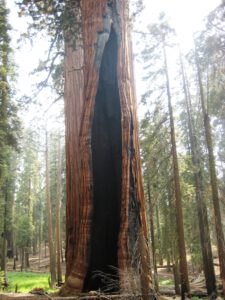
Between 2020 and 2021, 13% to 19% of the world’s population of large giant sequoias were killed by three large wildfires (the Castle, Windy, and KNP Complex Fires), including several thousand trees in Sequoia and Kings Canyon National Parks. While giant sequoias require frequent low- to moderate-intensity fire for healthy growth and regeneration, these fires burned so intensely that they overwhelmed even these great survivors’ natural defenses. Some areas were so affected that no mature living trees remained to reseed the ground. Most of these catastrophically burned areas had not experienced fire in recent years, and because of that, carried heavy fuel loads that caused fires to burn more intensely.
“In the midst of a new era of extreme fire behavior fueled by climate change, this work is an important step towards ensuring the long term viability of the ancient giant sequoias and protecting them from future losses,” said Chuck Sams, director of the National Park Service. “We have the tools to protect this iconic species and will deploy them as needed.”
“The fires of 2020 and 2021 underscored the importance of deploying all tools at our disposal to protect sequoia trees,” said Clay Jordan, superintendent of Sequoia and Kings Canyon National Parks. “Park managers are assessing the appropriate fuels reduction tools for each grove on a case-by-case basis.”
Most of the work this fall will include manual thinning of excess vegetation. The trimmings from thinning will be burned on site in piles, or as part of a prescribed burn, or a combination of the two. As the project continues, park staff will provide more details for individual components of the project, including when smoke impacts are anticipated. Additional work may include possible replanting of six sequoia groves that burned at high severity in 2020 or 2021 and have been determined to be at risk for total failure of natural regeneration. Assessments of these areas are currently underway. The earliest this work might begin is fall of 2023.
Sequoia and Kings Canyon National Parks have a prescribed burning program that dates back more than 50 years. Most of this work has been focused on medium- to high-use areas, including 10 sequoia groves, to protect the spectacular natural ecosystems as well as human safety and infrastructure. These decades of work have proven to be effective in areas such as the Giant Forest in Sequoia National Park and Grant Grove in Kings Canyon National Park. This work will help protect many of the more remote giant sequoias by reducing the amount of hazardous fuel in thus-far untreated groves.
